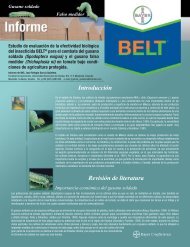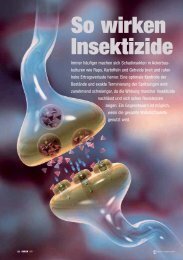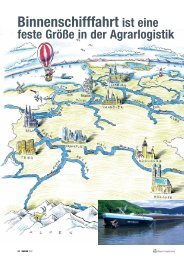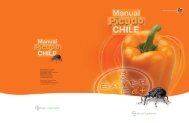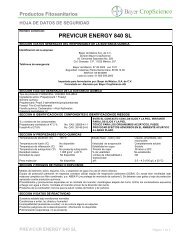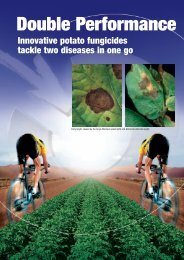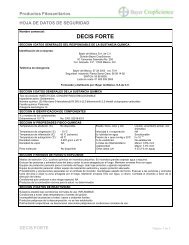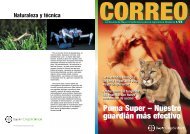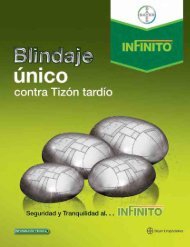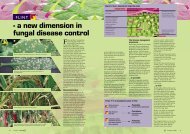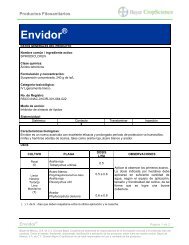Download: ( 586 KB pdf) - Bayer CropScience Mexico
Download: ( 586 KB pdf) - Bayer CropScience Mexico
Download: ( 586 KB pdf) - Bayer CropScience Mexico
You also want an ePaper? Increase the reach of your titles
YUMPU automatically turns print PDFs into web optimized ePapers that Google loves.
Reforma de Salud: Lo que todoPatrono Debe ConocerCámara de Comercio de Puerto Rico9 de diciembre de 2010Lcda. Sandra L. Negrón MongeCounsel787-250-2638sln@mcvpr.com
The Strengths of Arize HybridRice Seed<strong>Bayer</strong> <strong>CropScience</strong> has been present in allmajor rice growing countries for manyyears and is familiar with local cultivationpractices in most Asian and Latin Americancountries. By combining high qualityhybrid seed varieties marketed under thebrand Arize ® with state-of-the-art cropprotection products, <strong>Bayer</strong> <strong>CropScience</strong>optimizes the performance of hybrid ricecrops and offers farmers seed protectionfrom sowing through to harvest.Arize ® hybrids yield consistently at least+20% (or minimum 1 mt) above the bestnon-hybrid varieties, and as much or morethan competing hybrids. In terms of revenue,Indian studies have shown farmerrevenue increases due to high harvests ofArize hybrid rice of around 72 per centcompared with inbred lines. Likewise, inthe Philippines, the average net income isalmost doubled with Arize Bigante comparedwith inbred varieties.The seed is well adapted to diverse climaticand growing conditions and marketpreferences and offers excellent grain,cooking and taste quality. It has high puritylevels and high germination rates that meetor exceed legal standards.Hybrid Rice: GeographicalexpansionChina has been the center of excellence inhybrid rice technology and production forover 30 years. Hybrids are now cultivatedsuccessfully on about 55% of the ricegrowingareas and contribute to 66% ofChina's total rice production.Hybrid rice research in China began in1964 and the first cytoplasmic male sterile(CMS) line was developed in 1974 from amale sterile plant. The first commercialrice hybrid was developed in China in 1976and gave high-yielding varieties 20% higherthan that of commercial high-yieldingvarieties of similar duration (IRRN 29.1).China is indisputably the biggest and mostestablished hybrid rice market in the worldwith 16 million ha of hybrid rice, Chinarepresents 90% of the global hybrid ricearea (approx. 18 million ha).In other countries, the cultivation ofhybrid rice is still at an early developmentstage. India, Indonesia, Bangladesh, Vietnam,Pakistan, the Philippines, the UnitedStates, and Brazil have quite recently introducedhybrid technology in rice, and cultivationis expected to expand quickly inthese countries. Other major rice producingcountries in Latin America should alsosoon enter the hybrid rice era as farmersadopt the higher yielding seed. <strong>Bayer</strong><strong>CropScience</strong> intends to make its hybridrice expertise and offering available tofarmers globally. ■Rachel Audige, <strong>Bayer</strong> <strong>CropScience</strong> SA, France<strong>Bayer</strong> <strong>CropScience</strong> currently commercializeshybrid seed in rice, cotton, canola and numerousvegetable varieties. To find out more, go tohttp://www.bayercropscience.comHybrid seed results from cross-pollinationbetween two inbred parent lines, one of which is male-sterileFemale parent• No pollen• Produces hybrid seedFCross-pollinationMMale parent• supplies pollengenotype+genotypeCreation ofHybrid SeedHybrid RiceF1 – 1 st generation• Every plant genetics identical• High yielding• Highly uniformSame HybridSeed isreplanted=genotypeHybrid RiceF2 – 2 nd generation• Every plant has adifferent genotype• Highly variable populations=genotypes2/06 COURIER 19



